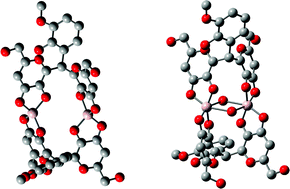Kojic acid derivatives as powerful chelators for iron(iii) and aluminium(iii)†
Abstract
Proceeding from a ligand constituted by two units of

* Corresponding authors
a
Dipartimento di Scienze Chimiche, Cittadella Universitaria, Monserrato, Cagliari, (Italy)
E-mail:
nurchi@unica.it
Fax: +39 070 675 4478
b Dipartimento di Chimica Inorganica e Analitica, Università di Cagliari, Cittadella Universitaria, Monserrato, Cagliari, Italy
c Protonic Software, Leeds, U.K.
d Department of Inorganic Chemistry, Faculty of Pharmacy, Campus Cartuja, University of Granada, Granada, Spain
e Department of Inorganic Chemistry, Faculty of Pharmacy, University of Santiago de Compostela, Santiago de Compostela, Spain
f Dipartimento di Chimica, Università di Ferrara, Via L. Borsari 46, Ferrara, Italy
g Faculty of Chemistry, University of Wroclaw, F. Joliot-Curie 14, Wroclaw, Poland
Proceeding from a ligand constituted by two units of

 Please wait while we load your content...
Something went wrong. Try again?
Please wait while we load your content...
Something went wrong. Try again?
V. M. Nurchi, J. I. Lachowicz, G. Crisponi, S. Murgia, M. Arca, A. Pintus, P. Gans, J. Niclos-Gutierrez, A. Domínguez-Martín, A. Castineiras, M. Remelli, Z. Szewczuk and T. Lis, Dalton Trans., 2011, 40, 5984 DOI: 10.1039/C1DT00005E
To request permission to reproduce material from this article, please go to the Copyright Clearance Center request page.
If you are an author contributing to an RSC publication, you do not need to request permission provided correct acknowledgement is given.
If you are the author of this article, you do not need to request permission to reproduce figures and diagrams provided correct acknowledgement is given. If you want to reproduce the whole article in a third-party publication (excluding your thesis/dissertation for which permission is not required) please go to the Copyright Clearance Center request page.
Read more about how to correctly acknowledge RSC content.
 Fetching data from CrossRef.
Fetching data from CrossRef.
This may take some time to load.
Loading related content
